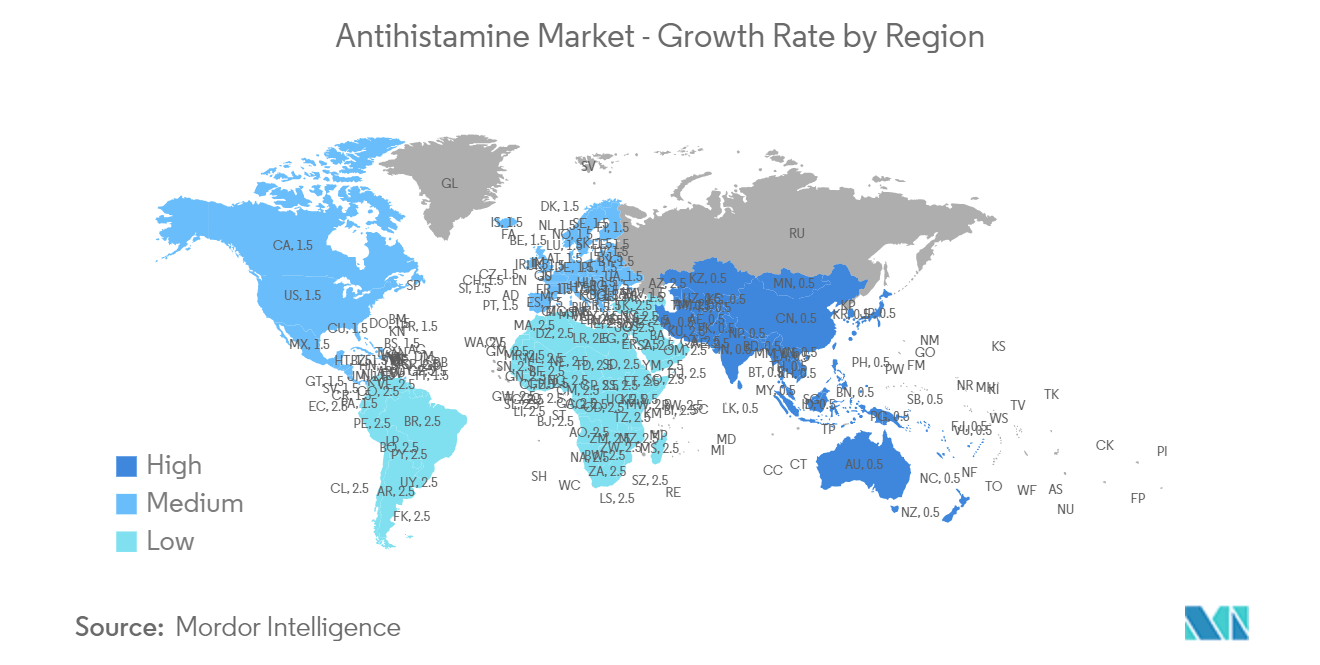Market Trends of Antihistamine Industry
Allergic Disorders Anticipated to Hold a Significant Share in the Market Studied
The allergic disorders segment is anticipated to hold a significant market share due to the rising adoption of antihistaminics in allergic conditions. In people with allergies, the body interprets allergens such as pollen, pet hair, or household dust as a threat and releases histamine. Histamine triggers an allergic reaction that manifests as itchy, watery eyes, runny or stuffy nose, sneezing, and skin rashes.
Rising initiatives from key market players, such as the launch of allergic antihistamine products, are anticipated to drive the segment growth. For instance, in July 2022, Dr. Reddy’s Laboratories Ltd launched the over-the-counter (OTC) Fexofenadine HCl 180 mg and Pseudoephedrine HCl 240 mg extended-release tablets in the United States. Therefore, launching OTC antihistamine drugs for allergies is expected to lead to increased adoption, driving segment growth.
Furthermore, the efficacy of antihistamines in treating allergies is anticipated to drive the segment's growth further. For instance, according to a study published in the Brazilian Journal of Otorhinolaryngology in June 2023, oral H1 antihistamines were the first-line therapy for patients with allergic rhinitis, and rupatadine, an antihistamine, was considered the most effective in alleviating symptoms of patients with allergic rhinitis. Therefore, the importance of antihistamine drugs in treating allergies is expected to raise the demand for the segment.
Therefore, rising initiatives from key market players, along with the high importance of antihistaminic drugs in treating allergies, are factors anticipated to show lucrative growth in this segment.

North America is Expected to Hold a Significant Share in the Market Over the Forecast Period
North America is anticipated to hold a significant share of the market studied due to the rising incidence of allergies, the strong foothold of key market players, improved healthcare infrastructure, medicare policies, and government funding for research and development of allergic disorders.
The rising prevalence of allergies is anticipated to drive the region's antihistamine market’s growth. For instance, according to the data published by the Centers for Disease Control and Prevention (CDC) in March 2024, around 60 million people in the United States are affected by allergic rhinitis symptoms annually. In addition, according to data published by the government of Canada in May 2024, more than 3 million people in Canada have food allergies. Such a massive prevalence of allergies in the region is anticipated to increase the demand for antihistamines to treat allergies, driving market growth.
In addition, the rising initiatives from key market players and approvals of antihistamine medications by national governments in the region are anticipated to boost market growth. For instance, in May 2023, in Canada, Bausch Health Companies Inc. launched its new prescription treatment, RYALTRIS (olopatadine hydrochloride and mometasone furoate nasal spray). This product is specifically used for the symptomatic treatment of moderate to severe seasonal allergic rhinitis (SAR).
Furthermore, increasing funds for researching and developing allergic conditions are expected to propel market growth. For instance, according to the National Institute of Health data updated in May 2024, research funding for food allergies was USD 77 million in 2022 and was estimated to reach USD 87 million by 2025. Hence, the increasing research funding helps develop new antihistamine therapy, which is anticipated to drive market growth during the forecast period.
Therefore, the above factors, such as rising allergy conditions, research funding, and initiatives from the key market players, are anticipated to drive market growth in the region.


